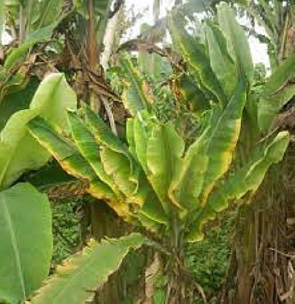The Biotechnology and Nuclear Agricultural Research Institute (BNARI) of the Ghana Atomic Energy Commission (GAEC) said it is ready to assist the agricultural sector fight the Banana Bunchy Top Disease (BBTD) should it invade the country.
The BBTD is caused by the Banana Bunchy Top Virus, and it is one of the most devastating banana diseases that also attacks plantains, wreaking havoc around the world and resulting in huge economic losses. The disease is reported to be endemic in East Africa and, in recent times, has been found in Cameroon, Nigeria, Benin, and Togo, moving towards Ghana.
The manager of the Biotechnology Center at BNARI, Dr. Andrew Sarkodie Appiah, made this known yesterday during an interaction with the Officers of the Commercialization and Communication Directorate of GAEC. He noted that the Commission has the technologies, such as Tissue Culture and Mutation Breeding, to help manage the disease in the short and long terms, respectively, if it is found in the country.
Dr. Sarkodie Appiah, who is also a plant virologist, stated that the disease was found in Togo in 2018 and that, even though reports suggest that it has been contained and prevented from spreading beyond the borders of Togo, there is a possibility that the disease may be lurking along the eastern borders of Ghana.
"Given the socio-cultural dynamics of our borders and the fact that our borders are quite porous, there is a need for the country to clear all doubt that our bananas and plantains are safe and free from this devastating disease," he said.
"Therefore, it is crucial that a thorough investigation is carried out as soon as possible along the border communities to ensure that it has not entered the country, and then the necessary steps can be taken to either prevent it from crossing the borders or apply the technologies required to produce new plants free from the disease," he added.
The plant virologist explained that once the plants are infected, it takes a long time for the disease to manifest itself, which, he said, makes it dangerous for the banana and plantain industries and the country’s economy at large.
He also stated that the disease is spread through a vector called banana aphids and that it can gain access to the country through transboundary trade. "Long-distance transmission is also facilitated by human movement of infected plant materials," he added.
"With the current economic crisis, it will really be a double jeopardy if this disease gains access to the country, and even more so if steps are not taken quickly to produce disease-free plants. Bear in mind that plantains in particular are one of the main staple foods in the country, and Ghana is the largest producer of plantains in West Africa and the second in Africa," he said.
Dr. Sarkodie emphasized GAEC-BNARI’s readiness to collaborate with the Plant Protection and Regulatory Services Directorate (PPRSD) of the Ministry of Food and Agriculture as well as other relevant stakeholders to take the necessary steps to ensure quality checks at the ports of entry and, when necessary, produce disease-free planting materials.
"We have a state-of-the-art laboratory and the expertise to support PPRSD to prevent the disease from causing harm to the economy. We already collaborate and work on projects with PPRSD, so our collaboration will not be new," he noted.
He indicated, however, that GAEC-BNARI would need support in the form of research funding for the project and also a tax exemption on the reagents to be used in the laboratory.
Dr. Sarkodie Appiah made an urgent plea that farmers be educated about the signs and symptoms of the disease to enable them to identify it and report it to the appropriate authorities.
“Individuals bringing planting materials into the country should be sensitized on the need to submit the plants at the ports of entry for quarantine checks and clearance,” he stressed.
He explained that some of the signs and symptoms of the disease include stunted growth, bunchy tops or rosette appearance, yellowing of leaf margins, a drastic reduction in yield, and in extreme cases, a complete loss of fruit production.
General News of Thursday, 17 November 2022
Source: GAEC













